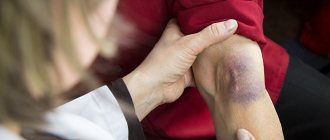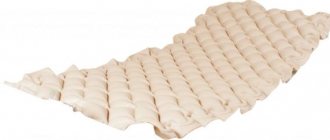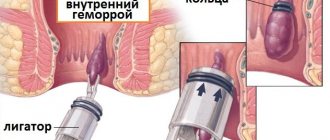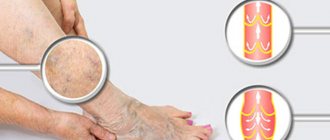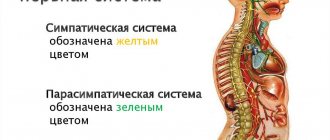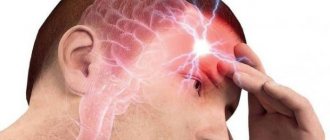Why do spider veins appear on the legs?
Spider veins and spider veins on the legs are an expansion of small intradermal veins, as a result of which they become visible as “bluish veins.” The main reason for their appearance is hormonal status: female sex hormones help reduce the tone of the veins. Accordingly, in the overwhelming majority of cases they occur in the female part of our population. This may also explain their frequent occurrence during pregnancy. In addition, contributing factors include hereditary predisposition and prolonged static loads.
Why do small purple veins develop on the legs?
The early stages of the formation of varicose veins are characterized by the appearance of small purple veins on the skin of the legs. This form of the disease is called reticular varicose veins.
Phlebologists believe that for the development of the disease several factors must act simultaneously. And yet the greatest influence among them is exerted by heredity and the hormonal background of the body. Therefore, the problem of “spider veins” mainly worries women and girls.
After all, it is the period of pregnancy, childbirth and menopause that is accompanied by the most significant hormonal changes. In addition, uncomfortable tight high-heeled shoes, prolonged standing or sitting, as well as excess weight can negatively affect the condition of the veins.
How to get rid of spider veins on your legs?
Conservative treatment (especially wearing compression stockings) is quite effective in preventing the occurrence of spider veins. However, if they have already appeared, there are two main treatment methods:
- Sclerotherapy. Using an injection, a sclerosant is injected into the main feeding vessel - a substance that causes damage and gluing of the vessel walls. Within 1-2 weeks, the vessel and the vascular network it feeds become fibrotic and disappear. The method is very effective for larger vessels.
- Percutaneous laser coagulation. Typically a neodymium laser is used. It passes through the transparent upper layers of the skin and is absorbed by the hemoglobin in the blood. The vessel heats up and it is “soldered”. This method is more effective for smaller vessels.
Red vein on black body
Intellectuals in a peasant country
After the collapse of the empire and the proclamation of the republic, Vienna stood out from the rest of the country. The first to leave the imperial capital of an ordinary, far from the most powerful country, were officials of the imperial ministries and officers. They returned to their native land. Meanwhile, Vienna was flooded with refugees from the eastern borders of the former empire, settled soldiers, and there were no fewer workers. Vienna's middle class was mired in financial problems due to many war bonds that had become meaningless. The new territorial division made it difficult to supply goods to the big city. Diseases naturally spread in crowded apartments: tuberculosis, Spanish flu, syphilis. The huge old capital of a radically different country received the nickname “Wasserkopf”, that is, dropsy, from the religious and conservative province.
Vienna and its Café Central have become a point of attraction for intellectuals
In a similar situation, on May 4, 1919, elections were held in the city. Townspeople and townswomen over 18 years of age elected Social Democrats. The left received an absolute majority in the Gemeinderat, the city parliament. The devastation after the First World War opened up a wide field of opportunities for reforms for socialists. In addition, there were “tools” for this too. In addition to the socialists themselves, led by Karl Seitz and Otto Bauer, there were a huge number of talented and intelligent people in the capital. A few names are especially famous in Russia, but they are just the tip of the iceberg: Ludwig Wittgenstein, one of the greatest philosophers of the 20th century, Sigmund Freud, now vulgarized by pop culture, and Arnold Schoenberg, the expressionist composer.
Legalized separation of the capital and the province
At first, after the proclamation of the republic, the reds and blacks acted together. The alliance of Social Democrats with Christian Democrats adopted laws on an eight-hour working day, a system of unemployment benefits was developed, and the Chamber of Workers was created as a lobbying structure. Enthusiasm for such reforms became less and less as the Christian Socialist Party continued to hold power since the end of the First World War.
Karl Seitz, Mayor of Vienna, 1925
In 1920 the coalition collapsed, and from then until 1945 the Social Democrats were - at the federal level - either in opposition or underground. But the Reds continued to rule Vienna, gaining an absolute majority in parliament in the 1919 elections. Their goal was to make Vienna a shining example of successful social democratic politics. The socialists themselves called this policy a “revolution of souls”: socialism was not supposed to win in Austria through dictatorship.
Their measures were considered outstanding or even spectacular at the time and were followed throughout Europe. Conservatives in Austria generally hated this kind of politics, but at that time they could do nothing against the success of the Social Democrats in the elections in Vienna.
After 1934 John Gunther Fr.
Otto Bauer, politician, Austro-Marxist theorist and general secretary of the Social Democratic Party of Austria, 1919
Vienna was the center of Lower Austria for seven centuries, and it remained so even after the fall of the empire. With power in Vienna, as well as workers' votes in the city of Wiener Neustadt, the Reds won the right to nominate a candidate for governor (Landshauptmann, literally meaning "captain of the land") of Lower Austria in 1919. They elected Albert Sever. But the rural areas did not want to submit to the Reds, and the right-wing forces also did not want to allow the socialists to gain strength. It is also important that being part of one land allowed the provincial authorities to interfere in the life of Vienna. The warring parties decided that it was better to separate Red Vienna from “black Lower Austria.” On January 1, 1922, Vienna became a separate federal state.
What exactly did the socialists do? Housing issue
Due to the law “On the Protection of Tenants” adopted by the imperial government, rental prices were frozen during the war at the 1914 level. This also created a housing shortage after the war, since for four years no new housing projects were carried out due to unprofitability. The housing issue was extremely acute.
After the war, the demand for land from merchants was low, and construction costs were low. This helped the city authorities to plan their social construction program well.
Karl-Marx-Hof
From 1925 to 1934, the Gemeindebau (“building community”) built buildings with more than 60 thousand new apartments. Residential areas were built around green spaces. For example, Karl-Marx-Hof, which later became one of the hot spots in the 1934 conflict.
Social housing tenants were selected based on ratings. For example, people with disabilities received additional “points”. 40% of all construction costs were taken from revenues from the Viennese housing tax, the rest from revenues from the Viennese luxury tax and from the federal budget.
The use of public funds to cover construction costs made it possible to set very low rental rates for such apartments: in apartment buildings, the cost of renting housing was 4% of family income; the cost of renting private houses was 30%. Additionally, if tenants became ill or became unemployed, rent payments could be deferred
Social sector reform
As the authors of the project put it, so that “not a single child in Vienna should be wrapped in newspaper,” parents received a “package of clothes” for each child. The city also needed women to return to work while children were not roaming the streets. Therefore, kindergartens, "afternoon houses" and children's resorts were opened.
By spending money on youth homes, the city saved on prisons
At the same time, medical services began to be provided free of charge. To improve the health of city residents, sports grounds, public baths and sports facilities were created. As Julius Tandler, member of the city council for social and health services, put it:
.
Budgetary spending on social services was increased threefold compared to the pre-war period. Infant mortality has fallen to below the Austrian average, and the number of tuberculosis cases has dropped by 50%. Affordable tariffs for gas, electricity and garbage collection, administered by the municipality, helped improve the sanitary condition of the city.
Where did they get the money from?
The Social Democrats raised money very simply: by introducing new taxes in the city. Municipal taxes became an addition to federal ones. Critics have dubbed them "Breitner taxes" after Hugo Breitner, the city's finance councilor. As already mentioned, these were taxes on luxury: on riding horses, large private cars, servants in private households, and also hotel rooms.
Victor-Adler-Hof
The Austro-Marxists also introduced a tax on housing construction. The tax was progressive and levied in increasing percentages. Revenues from the tax were used to implement the housing program. Many social housing estates still have signs that read: “Built with proceeds from the housing tax.”
Austro-Marxists consistently refused to take loans
The municipality's investments have reduced the unemployment rate in Vienna in relation to the rest of Austria and even to Germany. What is most characteristic is that all investments were made at the expense of taxes, that is, the citizens’ own funds, and not loans. the city administration remained independent of creditors and did not have to pay interest on the bonds.
The aforementioned Hugo Breitner, who for some reason did not become an example for the Austrian Social Democrats after 1945, consistently refused to take loans to finance the social sphere. These services consequently had to be cut when the federal government began to strangle Vienna financially in the early 1930s. The city lived within its means.
Political situation in the country. Austrofascism
All of the above applies only to Vienna. In the rest of the country, other ideas and trends prevailed. So the conservatives had a radically different vision of how Austria should develop. Right-wing ideologists spread the opinion in society that “Western democracy” and the parliamentary form of the state are unacceptable for Austria. Their idea was the rejection of class struggle and “all-class reconciliation.”
Later, the Austrofascists would abolish trade unions and recreate guilds on medieval lines. This was one of the attempts to find a third way. Then, in German post-war society, thoughts about the “decline of Europe”, that Germany and Austria are not Europe, but something in the middle, were very popular. There was a massive disappointment in the old order, both in its own way - the monarchy, and in the order of the winners - democracy. A special path was needed. It was found in corporatism, in an orientation towards the Middle Ages and the great past.
Heimwehr parade on October 7, 1928 in Wiener Neustadt
In May 1930, the militant organization of the right, Heimwehr, took the so-called “Korneuburg Oath” to fight for the complete elimination of parliamentary democracy and replace it with the “power of patriots” in a broad alliance with the public and the church. The Social Democrats won the 1932 local elections in Vienna; The losing right-wing forces feared defeat in the national parliamentary elections, and headed for a forceful seizure of power and the abolition of democratic elections altogether. This course was actively supported by Benito Mussolini.
The situation is heating up. On the way to a revolution
Clashes between right and left have been common in Austria since 1921. It is very important to understand that both sides had military organizations. For the socialists it was the “Republican Defense Union”, also known as the “Republican Schutzbund”, for the Austrofascists it was the “Homeland Defense Union”, or “Heimwehr” and the “Union of Front-line Soldiers”. Both there and there were thousands of front-line soldiers of the First World War.
During a demonstration in May 1927, far-right fighters from the Union of Frontline Soldiers fired at a left-wing demonstration in Schattendorf; a World War I veteran and an eight-year-old child were killed. In July, three accused of murder were acquitted by a court, which sparked a national strike and mass protests in Vienna, which on July 15 turned into open clashes between protesters and the Schutzbund on one side and the police and Heimwehr on the other.
Schutzbund parade on October 7, 1928 in Wiener Neustadt
The crowd stormed and set fire to the courthouse, the police responded with fire - a total of 89 people were killed (85 of them were left-wing demonstrators), more than 600 people were injured. After these events, the number of right-wing militant organizations grew: “Freedom League”, “Bauernwehr” - “Peasant Militia”, which later became the “Green Front”, “Austrian Stormtroopers”.
Everything comes to an end
Despite this, overall the end of the 1920s was quite successful for the Austrian economy, which made it possible to raise wages and build municipal housing for workers and government employees. The Great Depression, which began in late 1929, led to mass unemployment and put an end to social programs, again intensifying the struggle between right and left.
In February 1933, a parliamentary crisis occurred due to the adoption of the minimum wage law. After parliamentary proceedings stalled and three consecutive speakers resigned, despite the remaining possibility of overcoming the crisis through parliamentary methods, on March 4, Chancellor Engelbert Dollfuss (Christian Social Party) dissolved parliament. What followed was a series of actions that established the corporate dictatorship of a group of conservatives equally removed from the Austrian left and the German nationalists.
How fascism was built. Chronicle
Three days after the dissolution of parliament, on March 7, the martial law adopted in 1917 was renewed. All mass processions and meetings were banned, censorship and state control over the economy were established.
On March 12, Viennese Cardinal Innitzer publicly called on Catholics to support the coup. The church became one of the pillars of the new regime, with minor reservations.
Three days later, the police, under the guise of martial law, prevented the reunification of parliament (Christian socialists boycotted the reunification, and only leftists and “Great Germans” - supporters of unification with Germany) came to parliament.
Engelbert Dollfuss, Austrofascist leader
On March 31, the Schutzbund was banned. On April 10, the separation of schools from the church was abolished, and the author of the law was sent to the Wöllersdorf concentration camp. On May 10, all elections were canceled. On May 20, right-wing forces and the church united into the Fatherland Front, which became the support of the Dollfuss regime. It was an ultra-right Austrofascist (but not Nazi) party.
Soon, on May 26, the Communist Party was banned. On July 19, the NSDAP joined it. On August 16, the state and the church concluded a concordat. In September, concentration camps were urgently built. At the end of October, Pope Pius XI declared his support for “the distinguished statesmen of Austria.” On November 11, the death penalty was reinstated for murder, arson, vandalism and destruction of other people's property.
Due to the fact that the Austrian left was the most obvious threat to power, the Dollfuss regime immediately arrested many left-wing activists. After the ban on all other political parties, the liquidation of parliament and democracy, the Fatherland Front occupied a monopoly position in Austrian politics. Communist activities were firmly driven underground, but Social Democrats and trade unions still remained an influential force.
February uprising of 1934
The lightning civil war began with a search of the headquarters of the Social Democrats in Linz on February 12, 1934. The search sparked a clash between police and leftist militants. The shootout in Linz was the beginning. The conflict engulfed major cities in Austria, most notably Vienna. There, the Schutzbund barricaded itself in workers' quarters built in the 1920s. Places such as Karl-Marx-Hof and Sandleitenhof became strongholds of the uprising. The police and Fatherland Front militants settled in the neighboring blocks. First from small arms.
After the defeat of the uprising, executions and exiles of socialists began
The day after the search in Linz, the army entered the conflict. The leftists were crushed by artillery fire. By the end of February 13, Social Democratic strongholds in Vienna and Upper Austria had ceased resistance. On February 14, the Viennese district of Floridsdorf surrendered, where the fire brigade led by Georg Weissel joined the rebels. It was possible to suppress the center of resistance in Florisdorf only with the help of asphyxiating gases.
Georg Weisel, Austrian chemist and fire brigade leader, active participant in the February 1934 uprising against the Austrofascists
Until February 15, leftist resistance continued in Judenburg and Bruck aan den Mur. It is believed that by February 16, all centers of the uprising were suppressed.
In Vienna, more than 200 people died on the left side alone, and in total, up to 1,600 people died or went missing across the country on both sides. The government carried out mass arrests, filling the Wöllersdorf concentration camp, built back in 1933. In the wake of the uprising, the Social Democratic Party and its associated organizations were banned and destroyed. The leaders of the Social Democrats fled to Czechoslovakia.
The municipal quarter of Schlingerhof, built in 1925-1926, became a stronghold of left-wing militants in 1934
Those who remained in the country were shot by military courts that became widespread and had the right to punish by death by hanging. The first person to be hanged “in three days” was the feeble-minded dwarf Peter Strauss, accused of arson; behind him, dozens of prominent Social Democrats and trade union officials were hanged. For individual defendants who were of value to Christian Socialists, the possibility of pardon was retained.
By eliminating the Social Democrats and trade unions from the political scene, the Dollfuss government consolidated the alliance of conservative forces and the church. April 30 - May 1, 1934, the last meeting of legislators in the history of the first republic, completely controlled by the Dollfuss regime, took place, at which the so-called May Constitution was adopted. The Austrofascists borrowed it from the Mussolini regime.
Speech in support of the Schuschnigg regime, 1938
The Constitution, approved on May 1, 1934, replaced the state slogan of the first republic, “Austria is a democratic republic. The right belongs to the people” with the slogan of the class clerical state: “In the name of God Almighty, who grants all rights, the Austrian people received this constitution for their Christian German union state, built on the principle of class.”
*****
Despite the death of Dollfuss from a bullet from an Austrian SS militant, Austrofascism lasted until 1938, until the Anschluss.
Which is better: sclerotherapy or laser coagulation?
These methods are not opposed, but rather complement each other. Larger vessels are better removed by sclerotherapy (it is easier to puncture them with a needle and inject the drug, there is less chance of rupture of the vein during injection, correctly administered sclerosant in the form of foam almost 100% leads to gluing of the vascular network). A small vascular network is difficult to treat with sclerotherapy due to technical reasons (the diameter of the vessels of the network can be comparable to the diameter of the needle). And for percutaneous laser coagulation, this is an advantage, since it is easier to heat and “seal” such a vessel with a laser without the possibility of burning the overlying skin. Thus, first, large vessels are removed using sclerotherapy, and then small ones are “reached” with a laser.
Blood clot in the legs: the most common symptoms
15.10.2019
The formation of a blood clot in the deep veins of the lower extremities is a dangerous disease, as there is a risk of life-threatening complications. The thrombus can break away from the vascular wall, and the venous system reaches the heart and pulmonary artery - a pulmonary embolism occurs. When the pulmonary artery is completely blocked by a blood clot , sudden death occurs.
An increased risk deep vein thrombosis occurs in smokers, pregnant women, the elderly, patients with obesity , tumors, and blood .
What are the risk factors for developing a blood clot?
Factors contributing to the formation of a blood clot:
- dehydration;
- prolonged immobilization, such as air travel;
- presence of varicose veins ;
- pregnancy ; injuries, operations ;
- blood disorders ;
- medicines - contraceptives;
- obesity.
There are three main mechanisms for the formation of blood clots:
- damage to the wall of a blood vessel . If there is damage to the vascular wall (rupture, trauma, tingling), adrenaline, norepinephrine and serotonin are released, causing vasospasm . Platelets, and then white and red blood cells cling to the lesion - a blood clot ;
- venous sagging - delayed blood flow and congestion in large vessels favor thrombosis ;
- increased blood - Increased blood occurs during injuries, surgeries, tumors, burns, and dehydration.
What are the symptoms of a thrombus (blood clot) in the veins of the lower extremities?
At an early stage, when the blood clot is small and does not completely block the lumen of the affected vein , there is no inflammation and symptoms may be absent.
Here are some classic symptoms you may experience with a blood clot in your legs:
- spontaneous pain. In some cases there may be little pain, such as heaviness or discomfort, and in other cases there may be quite a lot of pain. In an upright position, the pain intensifies;
- painful pain in the course of large vessels ;
- pain in the groin of large vessels occurs in the area of the inguinal fold, in the buttock, inside the thigh;
- provoked pain. Pain occurs in the following cases: in the dorsiflexion of the foot pain is provoked, in the lower part of the leg - due to the release of the tibial veins ; coughing and sneezing cause pain in the corresponding limb;
- swelling. Painful swelling in the area of the clot - ankle, lower leg . It is typical for the swelling to not go away with cold compresses and may be enlarged for no apparent reason;
- change in skin color. The skin turns red and then turns blue-gray. The appearance of red spots on the skin in the area of the clot is a characteristic sign of the formation of a blood clot in the deep veins . These spots do not disappear over time, but become larger;
- warming of the skin. Increased skin temperature in the area of the blood clot is a relatively early sign. Warm skin may be accompanied by other symptoms such as itching, throbbing;
- dilated superficial veins - dilated veins around the ankle, lower leg, at the base of the thigh dilate;
- general symptoms are increased heart rate, fever, dizziness , anxiety.
Published in Phlebology Premium Clinic
Is it possible to cure spider veins at home?
At home, you can and should prevent the appearance of spider veins. The most effective method is, of course, wearing compression hosiery (at least during pregnancy, on days of increased or prolonged static loads). Venotonic drugs have some effectiveness. A contrast shower, periodically throughout the day raising the legs above the level of the heart, and massage of the lower extremities (provided there are no varicose veins) will also be useful. However, it will not be possible to remove spider veins that have already appeared on the legs at home. This will require special procedures that can only be performed in a specialized clinic (sclerotherapy, percutaneous laser coagulation).
Be healthy!
Sign up for a free consultation with a phlebologist or ask any questions you have about phlebology and vein treatment by phone:
+7 (495) 255−50−11.
Do small purple veins on the legs need to be treated?
Many people expect that small capillaries and purple veins can be removed using ointments or traditional medicine recipes. But given that varicose veins are an irreversible process, it is impossible to return the veins to their previous state and restore function with external medications.
In this regard, phlebologists strongly recommend treating the disease at the stage of minimal changes in the vessels. In addition to basic treatment, special attention should be paid to preventing the development of complications.
Complications of varicose veins include such serious conditions as pulmonary embolism, thrombophlebitis, trophic ulcer on the skin, and rupture of a vein in the leg. The best prevention of varicose veins and its complications is a healthy lifestyle. This concept includes:
- Proper, balanced nutrition;
- Drinking regime;
- Active physical activity;
- Healthy sleep;
- Rejection of bad habits;
- Regular medical examination.
What do the capillaries on the legs look like?
Every girl dreams of perfect skin. Of course, first of all, you need to take care of your hands and face. However, do not forget about the beauty of your legs. For most women, the problem of cellulite on the thighs becomes the main one, although the formation of a vascular network is considered not the least flaw.
The vessels that become visible on the surface of the skin are very thin, their diameter is about 0.3 millimeters. The extent of the visible area varies and depends on the degree of the defect, as well as the load on the capillaries. Their shape sometimes varies and depends on the structure of the blood vessels.
The vascular network, consisting of capillaries, is:
- Linear - one or more straight or tortuous capillaries are directed parallel to each other.
- Cobweb-like - the twists resemble the web of a spider, there is a center, as well as rays emanating from it to different edges.
- Tree-like - the shape resembles a branching tree.
- Spot-like - the vessel itself is located deep in the skin tissues, and moderate redness becomes visible on the surface.
The color of the vascular network depends on which vessel itself has the defect. The network of capillaries on the legs is red. However, gradually its color can become darker and also brighter. For example, bluish, brown. This is explained by the fact that the disease develops, that is, further distortion of the vessel walls occurs.
Essentially, reddish capillaries appear on two legs. There may be more of them on one side. The disorder is mainly found in the knee joint area. In second place in the frequency of manifestations of pathology is the outer thigh area. Then in descending order - the outer, as well as the front part of the lower leg, the lower zone of the hips, ankles and feet.
Peeking out small capillaries in themselves do not cause pain, so the problem is only in terms of beauty. But there is no need to let the situation take its course. And before trying to solve the problem with cosmetic methods, it is better to consult with a specialist to prevent complications.


